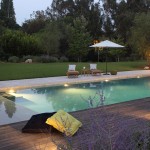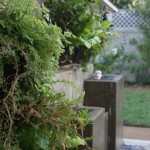- Of course, water itself is unmatched in its ability to inspire calm. Serene, modern lines form the hardscapes around the pool, and the traditional lawn also reflects that desire for calm. To capture the aesthetic of the closely cropped traditional lawn with a lower water and maintenance needs, the IdealMow lawn grass could be used throughout the space and infrequently mown to take on a clipped, manicured appearance.
- The path to the pool delivers a subtle “crunch” sound to reward each step.
Water brings tranquility, balance and movement to an outdoor space, qualities nearly impossible to replicate with other materials. With the county and state mandating greater water conservation, it is natural to ask how these compelling features can be made to perform in a sustainable environment.
Design for Conservation
The easiest way to ensure the sustainability of a water feature is to consider water conservation in its design. For example, using existing water to feed a feature, reducing opportunities for evaporation, and decreasing the likelihood of water waste can greatly reduce the water consumption of a pool, pond, fountain or waterfall.
Even in our desert climate, it is sometimes possible to harness on-site water to feed water features. In some cases, the natural water table will be high enough to create a feature with existing bubbling water, eliminating the need to incorporate other water sources. More sophisticated designs can also utilize natural run-off or excess irrigation.
Reduce Evaporation
Once the water is pulled into a fountain, pool or pond, it is important to keep it there by reducing its evaporation rate. Intuitively, this can be accomplished by reducing the square footage of water exposed to air and sun. For example, waterfalls and other water features that fall into underground reservoirs instead of above ground reflecting pools and ponds will naturally lose less water. With swimming pools, where exposure is necessary, automatic covers can reduce water loss and also save energy. Minimizing spray by using fewer fountain spouts and projecting water less forcefully can also help by keeping water a collective body that will evaporate less quickly than spray.
Absorb Overflow
Reducing spray is one of many strategies for reducing water waste produced by water features. Pools and ponds that sheath off and hug the surface of a landscape will loose less water in both spray and overflow. If splashing is expected or desired from a water feature, placing permeable materials or plants nearby to benefit from extra water reduces water waste while mitigating the chances of run-off or slipping. Of course, re-circulating features that recycle water also reduce water waste.
As with most prized aspects of landscaping and outdoor living spaces, pools, ponds, fountains, and waterfalls can be designed and constructed using sustainable practices and strategies that conserve water. While designing-in quality is always the easiest option, it is also possible to retrofit many existing water features to consume and waste less water. If this interests you, please watch for our July 2009 newsletter, or Contact FormLA for a Water Audit.



